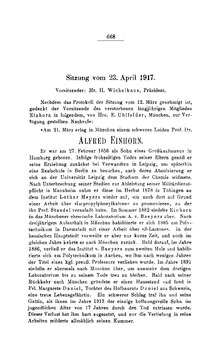Alfred Einhorn
Alfred Einhorn (born February 27, 1856 in Hamburg , † March 21, 1917 in Munich ) was a German chemist .
Life
Einhorn was the son of a Jewish merchant family from Hamburg. After the early death of his parents, he grew up with relatives in Leipzig and attended a secondary school in Berlin. After studying chemistry in Leipzig, he did his military service in Mannheim.
From the winter semester of 1878/79 he began his doctorate with Lothar Meyer at the Institute for Organic Chemistry at the University of Tübingen . With his dissertation on "Isopropylphenylketone" he received a habilitation position with Adolf von Baeyer in Munich in 1882 . His habilitation thesis on "β-lactones" apparently did not meet the requirements in Munich, in 1885 not at the Technical University of Darmstadt , but in 1886 at the Polytechnic School in Aachen . Here he was given the title of King. Prussian professor awarded.
In 1891 he got a job at the LMU Munich and shortly afterwards married in Munich. Einhorn had in 1905 for the first time in the same year to perform a spinal anesthesia by Heinrich Braun local anesthetic used procaine synthesized. He died after suffering severe illness at the age of 61.
Act
His research area focused on the synthesis of side-effect-free and cocaine- like local anesthetics . Synthetic methods have been known to be helpful
- 1898 the "unicorn variant" or unicorn acylation (pyridine addition) in the Schotten-Baumann reaction
- 1905 the Einhorn-Brunner reaction
The 100 or so new substances include
- Orthoform (4-Amino-3-hydroxybenzoic acid methyl ester) , 1887, effective but insoluble in water
- Nirvanin , effective, soluble in water, but locally irritating
- Novocaine (4-aminobenzoic acid-β-diethylaminoethyl ester), 1905, effective, water-soluble and locally irritant-free
Novocaine = Procaine (1905)
Benzocaine (today)
Lidocaine (today)
Tetracaine (today)
Novocaine was medically examined by the surgeons Heinrich Braun and Arthur Läwen and has been the standard local anesthetic for many decades. It was back then by the inking works. Master Lucius & Brüning AG taken over and today bears the international non- proprietary name Procain .
Famous collaborators of Alfred Einhorn
Arthur Eichengrün (1890 in Aachen) and Richard Willstätter (1894 in Munich) received doctorates from Einhorn . Willstätter succeeded in identifying the nitrogen-free breakdown products of cocaine for the first time, the true structure of which could only be clarified by Willstätter 20 years later.
Honors
- 1891: Member of the Leopoldina
Web links
- Obituary: H. Wichelhaus: Meeting: Meeting on April 23, 1917 . In: Reports of the German Chemical Society . 50, No. 1, 1917, pp. 668-672. doi : 10.1002 / cber.191705001108 .
Individual evidence
- ↑ In 1885 there were contradictions to his research results in "About an aldehyde of the quinoline series which contains the aldehyde group in the pyridine nucleus" . The error was proven by Wilhelm von Miller and J. Spady, Technical University of Munich, and in early 1886 in Ber. German Chem. Ges. 19 , 130-134 (1886) published .
- ↑ Michael Heck, Michael Fresenius: Repetitorium Anaesthesiologie. Preparation for the anesthesiological specialist examination and the European diploma in anesthesiology. 3rd, completely revised edition. Springer, Berlin / Heidelberg / New York et al. 2001, ISBN 3-540-67331-8 , p. 803.
- ↑ Einhorn's Search for Cocaine Substitutes
- ^ Alfred Einhorn, Friedrich Hollandt, Mitgetheilt Von Alfred Einhorn: About the acylation of alcohols and phenols in pyridine solution. In: Justus Liebig's Annals of Chemistry. 301, 1898, pp. 95-115, doi: 10.1002 / jlac.18983010111 .
- ↑ A. Einhorn: About the N-methylol compounds of the acid amides [First treatise.] In: Justus Liebigs Ann. Chem. Band 343 , 1905, pp. 207-305 (1905) , doi : 10.1002 / jlac.19053430207 .
- ↑ Hans Loewe: From cocaine to novocaine. In: Arzneimittelforschung 1956; 6: 43-50.
- ^ Wilhelm Prandtl: The chemical laboratory of the Bavarian Academy of Sciences in Munich. In: Chymia 1949; 2: 81-97.
| personal data | |
|---|---|
| SURNAME | Unicorn, Alfred |
| BRIEF DESCRIPTION | German chemist |
| DATE OF BIRTH | February 27, 1856 |
| PLACE OF BIRTH | Hamburg |
| DATE OF DEATH | March 21, 1917 |
| Place of death | Munich |






